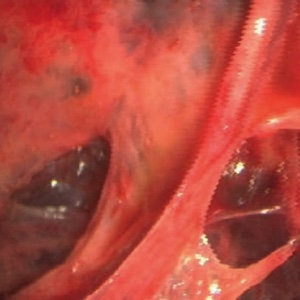Intracavitary fibrinolysis directly under vision during medical thoracoscopy: a case report

Submitted: August 8, 2022
Accepted: October 12, 2022
Published: November 2, 2022
Accepted: October 12, 2022
Abstract Views: 1004
PDF: 196
Publisher's note
All claims expressed in this article are solely those of the authors and do not necessarily represent those of their affiliated organizations, or those of the publisher, the editors and the reviewers. Any product that may be evaluated in this article or claim that may be made by its manufacturer is not guaranteed or endorsed by the publisher.
All claims expressed in this article are solely those of the authors and do not necessarily represent those of their affiliated organizations, or those of the publisher, the editors and the reviewers. Any product that may be evaluated in this article or claim that may be made by its manufacturer is not guaranteed or endorsed by the publisher.
Similar Articles
- Elio Gorga, Marta Scodro, Francesca Valentini, Renzo D'Ortona, Mariachiara Arisi, Edoardo Sciatti, Ivano Bonadei, Valentina Regazzoni, Enrico Vizzardi, Marco Metra, Piergiacomo Calzavara Pinton, Echocardiographic evaluation of diastolic dysfunction in young and healthy patients with psoriasis: A case-control study , Monaldi Archives for Chest Disease: Vol. 88 No. 3 (2018)
- Vishal Chopra, Hardik Jain, Akhil D. Goel, Siddharth Chopra, Ashrafjit S. Chahal, Neha Garg, Vidhu Mittal, Correlation of aspergillus skin hypersensitivity with the duration and severity of asthma , Monaldi Archives for Chest Disease: Vol. 87 No. 3 (2017)
- Amanda R. Jimenez, Arielle Shaeffer Weiss, Anthony C. Campagna, Use of pulmonary function test demographic data to identify high-risk patients for lung cancer screening , Monaldi Archives for Chest Disease: Vol. 88 No. 1 (2018)
- T. Kontakiotis, N. Manolakoglou, F. Zoglopitis, D. Iakovidis, L. Sacas, A. Papagiannis, A. Mandrali, D. Papakosta, P. Argyropoulou, D. Bouros, Epidemiologic trends in lung cancer over two decades in Northern Greece: an analysis of bronchoscopic data , Monaldi Archives for Chest Disease: Vol. 71 No. 4 (2009): Pulmonary series
- Cuneyt Tetikkurt, Nail Yılmaz, Seza Tetikkurt, Şule Gundogdu, Rian Disci, The value of exfoliative cell cytology in the diagnosis of exudative pleural effusions , Monaldi Archives for Chest Disease: Vol. 88 No. 3 (2018)
- S.M. Mirsaeidi, P. Tabarsi, A. Mardanloo, G. Ebrahimi, M. Amiri, P. Farnia, M. Sheikhleslami, V. Bakayev, F. Mohammadi, S.D. Mansouri, M.R. Masjedi, A.A. Velayati, Pulmonary Mycobacterium Simiae infection and HTLV1 infection: an incidental co-infection or a predisposing factor? , Monaldi Archives for Chest Disease: Vol. 65 No. 2 (2006): Pulmonary series
- Lucrezia Piccioli, Michele Arcopinto, Andrea Salzano, Roberta D'Assante, Alessandra Schiavo, Francesca M. Stagnaro, Anna Lombardi, Veronica Panicara, Pietro Valente, Giuseppe Vitale, Filippo M. Sarullo, Francesco Giallauria, Alberto M. Marra, The impairment of the Growth Hormone/Insulin-like growth factor 1 (IGF-1) axis in heart failure: A possible target for future therapy , Monaldi Archives for Chest Disease: Vol. 88 No. 3 (2018)
- Abhijeet Singh, Rajendra Prasad, Rajiv Garg, Surya Kant, Giridhar B. Hosmane, Abhisek Dubey, Abhisek Agarwal, Ram Kishun Verma, A study to estimate prevalence and risk factors of Obstructive Sleep Apnoea Syndrome in a semi-urban Indian population , Monaldi Archives for Chest Disease: Vol. 87 No. 1 (2017)
- Sumita P. Agrawal, Pranav Ish, Akhil Dhanesh Goel, Nitesh Gupta, Shibdas Chakrabarti, Dipak Bhattacharya, Manas Kamal Sen, Jagdish Chander Suri, Diagnostic utility of endobronchial ultrasound features in differentiating malignant and benign lymph nodes , Monaldi Archives for Chest Disease: Vol. 88 No. 2 (2018)
- P. Pirina, M. Budroni, S. Esposito, S. Ostera, M.F. Polo, L. Santoru, G. Madeddu, A.G. Fois, G.C. Ginesu, G. Padua, F. Tanda, F. Ginesu, Cytological and histological diagnosis of lung cancer in Sardinia and Italy in the 1990s , Monaldi Archives for Chest Disease: Vol. 67 No. 4 (2007): Pulmonary series
You may also start an advanced similarity search for this article.

 https://doi.org/10.4081/monaldi.2022.2400
https://doi.org/10.4081/monaldi.2022.2400





